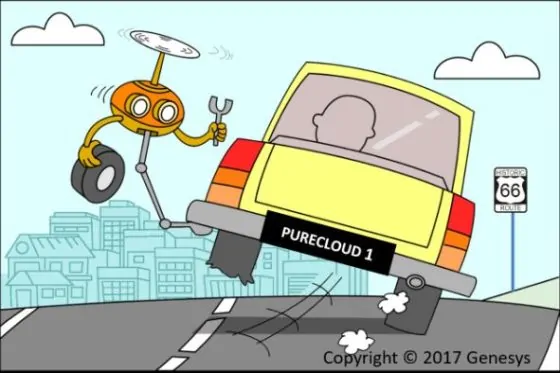Your Genesys Blog Subscription has been confirmed!
Please add genesys@email.genesys.com to your safe sender list to ensure you receive the weekly blog notifications.
Subscribe to our free newsletter and get blog updates in your inbox
Don't Show This Again.

https://www.genesys.com/platform/purecloud It’s the first day of your big cross-country road trip out West. You start your drive on historic Route 66, blasting your favorite tunes and following directions displayed on your in-dash navigational system. You’ve planned this trip for years and can’t wait to see the breathtaking landscapes and sights of Main Street, America. Suddenly, the car’s advance warning system beeps—drowning out your favorite song. The system warns you that your left tire is slowly losing pressure. This is going to cause a delay in your travel—and possibly ruin your visit to the weird Blue Whale in Catoosa, Oklahoma. But what if a flat tire didn’t have to delay your plans? Imagine if it were like the picture, and a pre-programmed automatic control system took over driving while a drone flew in to change your tire—without you having to stop the car or even pull over on the side of the road. While this all seems impossible and futuristic, something similar is happening in the software development world today. Welcome to the age of continuous delivery. While none of us expect that robots will change a tire on a moving vehicle any time soon, Cloud 2.0 platforms like Genesys PureCloud allow something similar to happen with regard to software deployment. Continuous delivery is the process of deploying iterative and incremental software code at any given time. Using this process, we can push new features, enhancements, updates and bug fixes to end users automatically. Gone are the days when businesses had to wait for a new software release to utilize new functionality; there are no more maintenance windows. You don’t have to take a break from daily operations to deploy and test new software versions like you had to with on-premise or hosted systems and legacy applications. And continuous delivery is just one of the benefits of a microservices architecture. In a microservices architecture, small, independent services encapsulate a singular functionality—enabling software teams to create new software code in short cycles. The new code is automatically released—efficiently and reliably—to bring service improvements to all users. These atomic code changes are rapidly pushed through the delivery pipeline—from development to testing to staging to production—for end-user consumption. Unintended consequences are minimal; fault isolation is simple, easily contained and fixed quickly. Development teams can spend less time investigating and patching defects, giving them greater confidence in their software builds and the ability to release new features faster. New features and functionalities are seamlessly and continuously integrated into the platform, allowing customers to consume them on their own schedule. Watch the video below to see how PureCloud is based on microservice architecture running atop the Amazon Web Services Cloud, and offers the reliability and flexibility to quickly and cost-effectively add services. A solid continuous delivery practice is a pre-requisite for a Cloud 2.0 platform. When evaluating cloud solutions, it is imperative to ask vendors about release cycles and their approaches to software delivery and upgrades. Unlike on-premise or hosted systems, Cloud 2.0 consumers are no longer forced to choose between speed of delivery, quality of software or low cost of deployment. You can have it all—leaving you with more time to plan your great American road trip. But you probably still need to keep that spare tire in your trunk—at least for now.
Subscribe to our free newsletter and get blog updates in your inbox.